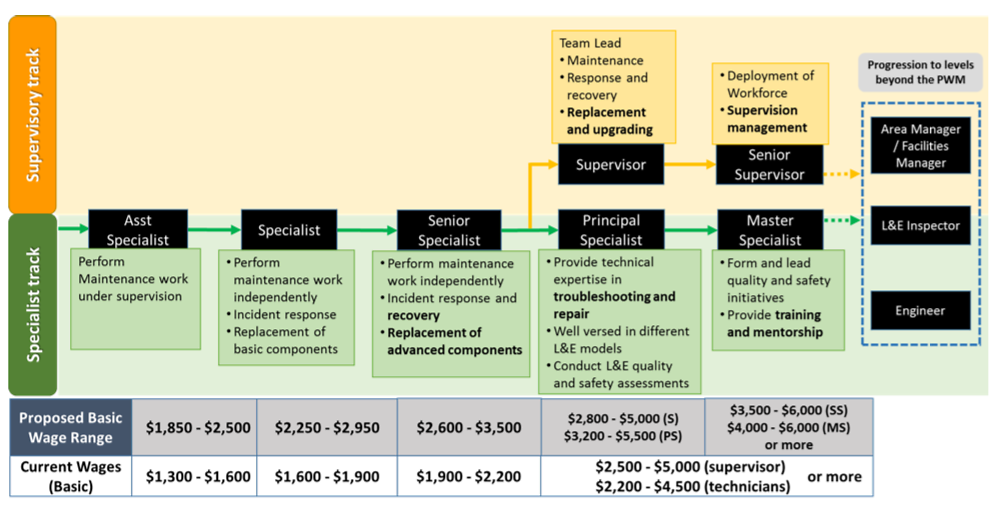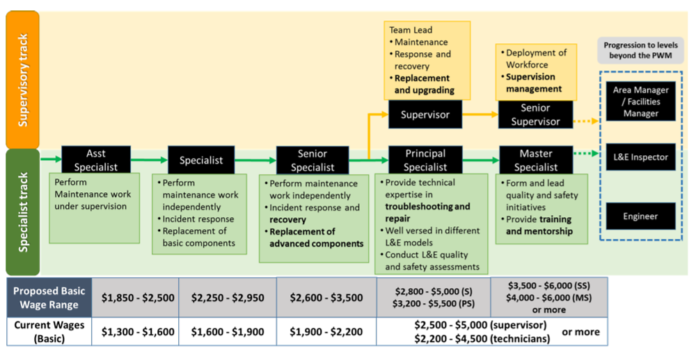SINGAPORE: Lift technicians in Singapore can expect better pay as the Government accepts recommendations made by the Lift and Escalator Sectoral Tripartite Committee (STC) on Wednesday (Sept 19).
The recommendations include mandating the progressive wage model (PWM), a wage ladder which helps workers grow their salaries as they acquire skills and improve productivity.
The PWM has been implemented for workers in the cleaning, security and landscaping sectors, making lift technicians the fourth group of workers to come under the wage ladder.
Minister of State for National Development and Manpower Zaqy Mohamad said the recommendations provide a useful roadmap in attracting, developing and retaining locals in the lift industry.
“If we do this well, it will translate into safer and more reliable lifts for all of us,” Mr Zaqy said.
“For a start, the Government will take the lead in supporting the Progressive Wage Model for the lift industry,” he added.
READ: 12,600 households to benefit from S$33m lift replacement programme
Along with the PWM, the committee has proposed a higher basic wage range for all levels of lift maintenance personnel to attract and retain a core Singapore resident workforce. This can also keep the sector competitive with other sectors requiring comparable technical skills.
For example, the current monthly basic wage for an entry-level lift mechanic is between S$1,300 and S$1,600. The recommendations called for this to be adjusted to between S$1,850 and S$2,500.
“One of the concerns of the lift companies is whether or not the service buyers will pay more for their lift maintenance contracts. That is also why the STC is recommending that the PWM (be) a mandatory one … so that it will level the playing field for all the lift companies in Singapore,” said NTUC assistant secretary-general Melvin Yong, who is also co-chairman of the STC.
CLEARER CAREER PROGRESSION TRACKS
Currently, there are about 2,100 lift technicians servicing 67,000 lifts islandwide.
Of them, 42 per cent are Singapore residents. About half of them are above 50 years old and are expected to retire within the next 10 to 15 years, the committee said.
To tackle the aging and shrinking industry, the committee said it wants clearer career progression pathways pegged to the PWM to attract more Singapore residents to join the sector.
As the number of lifts continues to increase, we project that we will need about 3,000 lift technicians over the next three years,” Mr Yong said.
Now, mechanics can be promoted to technicians followed by senior technicians. After that, senior technicians can be promoted to a supervisory role with lesser involvement in site-based work.

Under the recommendations put forth by the committee for lift technicians, more job roles will be created to build supervisory and technical capabilities of the lift industry. (Diagram: Lift and Escalator Sectoral Tripartite Committee)
However, those who want to stay in a technical role have little room for progression. Hence, the committee proposed an additional specialist track along with a supervisory track.
Those in the supervisory track will get to build up their management skills while those in the specialist track will get to deepen their technical skillsets.
UPSKILLING THE WORKFORCE
Currently, the Institute for Technical Education’s NITEC in Facility Technology (Vertical Transportation) is the only lift-specific qualification available in Singapore. There is also no standardised minimum requirement such as qualifications, training or certification for existing lift maintenance personnel at the rank-and-file level, the committee said.
READ: Professionalisation, wage ladder for lift technicians a long time coming
While lift firms provide in-house training through on-the-job-training, there is also no standardised approach or curriculum across the industry.
To address this, the committee recommended a training and certification framework aligned with the proposed PWM to ensure that all maintenance personnel is equipped with the key skills required.
It also recommended the creation of training courses to cater to fresh graduates without related qualifications and mid-career switchers through bridging courses and certification.
BCA is also working closely with ITE to develop training courses, assessments, and certificates aligned with the career progression pathways of the PWM. (Photo: Cheryl Goh)
For existing personnel, the committee is pushing for lift firms to conduct their own appraisals to place maintenance personnel at the appropriate levels based on the PWM. All personnel have to attain at least Specialist level competency under the PWM.
ITE and the Building Construction Authority (BCA) have agreed to develop training courses, assessments, and certificates to catered to varying competencies of lift personnel.
USING TECHNOLOGY TO ENHANCE WORK
To cope with the manpower shortage and an expected increase in manpower cost, the committee said that the industry should look into technology that can help enhance efficiency and reduce manpower reliance.
READ: AI eyed to bring lift maintenance to a higher level
One such example is the use of remote monitoring and diagnostics.
Currently, lift technicians must perform at least one routine check every month on a lift. It takes 45 minutes to 2 hours to shut down a lift and test its condition.
With remote monitoring, maintenance personnel can use sensors to check on lifts during off-peak periods without making the trip to the lifts. The data collected from sensors can also be used to pre-empt lift malfunctions or parts failure.
The committee also asked for an improvement in working conditions to make the industry a more attractive one.
“Today in the lift shafts, it’s dark and we need to also improve the ventilation. These are the conditions that the tripartite partners are also working very closely (on). A task force has also been set up and we hope that we hope that we will have some recommendations soon,” Mr Yong said.
Lift technicians will also see a renaming of their job titles to reflect the skills acquired as they progress up the ladder and to improve public perception. Entry-level mechanics will become assistant specialists, for example.
The implementation of the PWM will be phased over three years to give the industry sufficient time to adjust.





